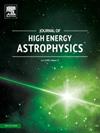伽马射线暴的持续时间
IF 10.5
4区 物理与天体物理
Q1 ASTRONOMY & ASTROPHYSICS
引用次数: 0
摘要
最近,一个具有超新星关联的短周期GRB (GRB 200826A)和两个具有千新星关联的长周期GRB (GRB 211211A和GRB 230307A)被发现,这打破了GRB持续时间与它们的祖系统之间的紧密联系的希望。在这里,我总结了影响GRB持续时间的各种物理因素,并提出GRB的持续时间可以由四个因素来定义:祖星、中心引擎、发射器和几何形状。祖先定义的持续时间仅在中央发动机由吸积提供动力以及其他因素的修改不重要时才有意义。持续时间-祖元不匹配的混乱状况表明,至少在某些GRB中,其他因素可能在定义GRB持续时间方面发挥重要作用。特别是,伽马射线暴可能不是由吸积驱动的,而是由毫秒磁星驱动的,至少对某些伽马射线暴来说是这样。GRB 211211A复杂的光曲线表明了祖星和引擎定义的持续时间,这可能需要一种新型的祖星系统,包括白矮星-中子星合并和磁星合并产物。GRB 230307A的单宽脉冲光曲线具有良好的能量依赖行为,表明它具有发射者定义的长持续时间。中央引擎的时间尺度可能足够短,可以容纳在一个标准的双中子星合并的框架内。它的尖尖的光曲线具有快速的变化,以及扩展的x射线发射表明,在全球耗散区存在由底层磁星提供动力的迷你喷流。本文章由计算机程序翻译,如有差异,请以英文原文为准。
On the duration of gamma-ray bursts
Recently, a short-duration GRB with supernova association (GRB 200826A) and two long-duration GRBs with kilonova associations (GRB 211211A and GRB 230307A) have been detected, which demolished the hope for a tidy connection between GRB duration with their progenitor systems. Here I summarize various physical factors that can shape the duration of a GRB and propose that the duration of a GRB can be defined by four factors: progenitor, central engine, emitter, and geometry. The progenitor-defined duration is only relevant when the central engine is powered by accretion and when the modifications by other factors are not important. The untidy situation of duration - progenitor mismatches suggests that other factors likely play important roles in defining GRB duration at least in some GRBs. In particular, a GRB may not be powered by accretion but rather by a millisecond magnetar at least for some GRBs. The complicated lightcurve of GRB 211211A suggests both progenitor- and engine-defined durations, which may require a new type of progenitor system involving a white dwarf - neutron star merger with a magnetar merger product. The single broad pulse lightcurve with well-behaved energy-dependent behavior of GRB 230307A suggests an emitter-defined long duration. The central engine timescale may be short enough to be accommodated within the framework of a standard binary neutron star merger. Its spiky lightcurve with fast variability as well as extended X-ray emission suggest the existence of mini-jets in the global dissipation region, powered by an underlying magnetar.
求助全文
通过发布文献求助,成功后即可免费获取论文全文。
去求助
来源期刊

Journal of High Energy Astrophysics
Earth and Planetary Sciences-Space and Planetary Science
CiteScore
9.70
自引率
5.30%
发文量
38
审稿时长
65 days
期刊介绍:
The journal welcomes manuscripts on theoretical models, simulations, and observations of highly energetic astrophysical objects both in our Galaxy and beyond. Among those, black holes at all scales, neutron stars, pulsars and their nebula, binaries, novae and supernovae, their remnants, active galaxies, and clusters are just a few examples. The journal will consider research across the whole electromagnetic spectrum, as well as research using various messengers, such as gravitational waves or neutrinos. Effects of high-energy phenomena on cosmology and star-formation, results from dedicated surveys expanding the knowledge of extreme environments, and astrophysical implications of dark matter are also welcomed topics.
 求助内容:
求助内容: 应助结果提醒方式:
应助结果提醒方式:


